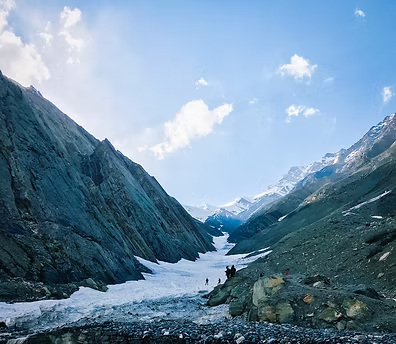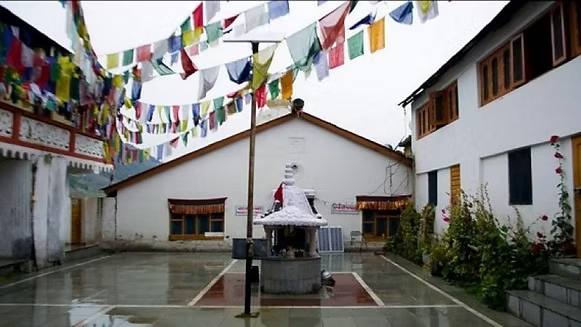Spiti valley, a cold desert mountain valley, is located in the north- eastern parts of Himachal Pradesh. The word “Spiti” means “the middle land” and thus Spiti is very aptly named as it is situated between India and Tibet. Spiti has beautiful landscapes, picturesque valleys and peaceful villages with a low population.

Spiti has a huge influence of Buddhism due to its geographic location and hence, religion plays a very important role in the day-to-day life of the people living in Spiti. Spiti, an untamed land of solitude and spiritualism, houses a lot of monasteries and temples. The soothing sounds of God praising chants in both temples and monasteries gives one a sense of relief or the “sukoon” that everyone misses in their lives.
So, if you want to experience that sukoon and see the serene architecture situated in and around the Spiti Valley, read on the following list of top religious places of Spiti Valley:
1. Trilokinath Temple

A temple visited equally by Hindus and Buddhists, the Trilokinath Temple is situated in the
Udaipur sub- division of Lahual District. In ancient times, the temple was popularly known
as Tunda Vihar. While Hindus consider the temple to belong to Lord Shiva, it is believed
that the Buddhists consider the temple to belong to the deity “Arya Avalokiteshwar or
Garja Fagspa.
This holy temple is very sacred as it is believed to be the Teerath Sthal next only to
Kailash and Mansarover and hence is a very important shrine. Though a lot of stories
are told about the history of the temple, one of the most commonly heard stories is: Back
in the 10th century, seven people used to come out of the lake (presently known as Hinsa
Nala) and drink the milk of the cows grazing nearby. One day, a cow herder boy saw
this and took one of them to his village. Upon reaching the village, the person turned into
marble and since then, a temple has been built around the marble deity.
The Hinsa Nala is believed to have milky white water which remains the same throughout the year even with changing weather.
Best time to visit: The best time to experience the beauty of the Trilokinath Temple is from
April- October.
2. Key Monastery

Also known as Kye Gompa, it is the largest monastery in Spiti Valley and houses about
250 monks who reside in the monastery throughout the year. It is situated 12km north of
Kaza.
Founded by Atisha’s (a famous teacher) pupil, Dromtön in the 11th century, but was
destroyed multiple times by Mongols, in wars between Ladakh and Kullu, by the Dogra
army under Ghulam Khan and Rahim Khan, Sikhs, fire and earthquake throughout history.
The monastery has a collection of ancient books and murals which include images of Lord Buddha. The walls of the monastery are covered with paintings, which is a result of
Chinese influence.
Best time to visit: The best time to visit Kye Monastery is in the summer season, during the
months of April- October.
3. Tabo Monastery

Protected by the Archaeological Survey of India as a national historical treasure of India,
Tabo Monastery was built in 996 AD by the Royal Lama Yeshe- O. It is also known as the
daughter monastery of the Tholing Monastery in Ngari (western Tibet).
Tabo is the oldest earthen Buddhist monastery in the Himalayan region and is also
referred to as the Ajanta of the Himalayas.
The temple complex constitutes Stupas, Fittings, Older Temples, Newer Temples and a
Main Temple. Tsug La Khang or the main temple, includes an assembly hall, an entry
hall, and a recessed area which has a shrine area. The older temples constitute the
Mahakala Vajra Bhairava Temple, the White Temple, the Large Temple of Dormton and the Chamber of Picture Treasures. The newer temples include the Golden Temple, the
Bodhisattva Maitreya Temple, the Temple of Dormton and the Temple of Enlightened
Gods.
Best time to visit: As the winters are harsh, the best time to visit is from May to October.
4. Mrikula Mata Temple

Believed to be built in the 11th or 12th century and is located just above the market at
Udaipur in Lahaul and Spiti. A large number of devotees visit the temple each year in
summer.
Though the temple is under the Archeological Department of Himachal Pradesh, they are
least concerned about the temple. The locals say that one of the walls have tilted and
may collapse anytime.
The temple has a huge significance for the devotees of Goddess Kali. The temple is built
in the Kashtuni style. While the temple looks old and simple, the inside of the temple has
Deodar wood carvings depicting the scenes from Mahabharata and Ramyana. The
temple is also famous as it is believed to be built at the place where Goddess Kali killed
Mahishasur and Raktbeej and hence is no less than a Shaktipeeth. The idol of Kali is
made of silver and is a mix of Rajasthani, Tibetan and Kashmiri styles and has an oddly
proportioned body.
The small and simple temple tells so many stories through its carvings and carries a lot of history with it.
Best time to visit: One can visit the temple during the summer months i.e., May to
October.
5. Kardang Monastery

A huge white building decked with prayer flags, it’s a very famous and the most
important Drukpa Lineage monastery in the Lahaul valley. Believed to be built in the
12th century, this monastery houses a large library of Buddhist literature which includes
the scriptures of the Sherpa language known as Kangyur and Tangyur.
The first room of the monastery is a 4-foot-high silver chaitya and preserves Lama
Norbu’s skull and ashes. Approximately 64 tantra books and 103 volumes of the
Kangyur are kept in this room. The second room is a prayer hall and has a statue of
Avalokitesvara, an eleven- headed statue.
The monks and nuns of the Kardung Monastery have equal rights and the monks have
permission to marry. They spend summers with their families and return to the
monastery in winter.
Best time to visit: The best time to visit this monastery is in the summer months from May
to October.
6. Giu Mummy

An extraordinary boy was born in the 14th century in Giu and came to be known as
Sangha Tenzin. Excelling in every field of study and mastering the Bhoti language, the
boy later embarked on the Buddhism path and left all the worldly pleasures to become
a monk.
Even though Giu was a happy place, the surrounding places had another story altoget
her. The surrounding mountains were constantly being harassed and threatened by the
demons who put a curse on the village. With no knowledge of how to get rid of the
curse, the people of Giu went to Lama Sangha Tenzin.
For the next few years, the Lama engaged in tantric practices and sacred mantras and
on the night of the full moon, got rid of the demons and also promised to continue to
protect the people of the village and took residing in a cave.
Hundreds of years passed and people eventually forgot about him only for the cave to
be destroyed by the earthquake along with the stupas that were kept in the cave with
him in 1975.
In the years that followed, as the caves were near the Indo- Tibetan border, the Indian
soldiers began constructing a road in and around the village of Giu. It was during the
construction that one of the broken stupas was discovered and while clearing the
rubble, a worker found a skull with blood oozing from it.
An astonishing fact was that even after 550 years of being earthed, the Monk’s body
was mummified naturally but had blood still flowing through the mummy and the hair
and nails continued to grow, hence signaling that Monk Sangha Tenzin kept his
promise of protecting the village and continues to live in the form of a mummy.
Best time to visit: The best time to see this extraordinary mummy is during the summer
months of May to October.
7. Tangyud Monastery

Also known as the Komic Monastery, it is situated in Komic village, which is pretty
famous for being the world’s tallest village accessible by road. The monastery was built
by the Sakyapas under the Mongol patronage in the 14th century.
This monastery has time and again stood against all natural disasters. Legends say that
the monks decided to shift the monastery to Hikkim village due to a drought but the
Mahakal statue, which is believed to be the Protector of Dharma, refused to move, along
with the monk who continued praying to the statue, even after the monks tried every
possible way.
During the 1975 earthquake, the monastery in Hikkim village was ruined but the
Mahakal statue and the praying monk stood adamant without any harm. One can also
visit the ruins of the Hikkim village, which is visible from the top of the mountain.
Best time to visit: People can offer their prayers to the protector during the summers from
May to October as winters make it very difficult to reach the monastery.
8. Gandhola Monastery

Gandhola Monastery is also known as Guru Ghantal Gompa and is located 18km
before Keylong, Lahaul. It is said to be founded in the 8th century CE by Guru Rinpoche and is now connected with the Drukpa Kargyu sect of Tibetan Buddhism.
Even though it was built in the 8th century, the place was a Buddhist establishment even
before that. In 1857, a chased goblet which dated to the 1st- 2nd century CE was found
at this location. This goblet is considered to be evidence of the presence of a Buddhist monk’s cell. Avalokitesvara’s damaged marble head was also found here and is said to
be dating back to the time of Nagarjuna in the 2nd century CE.
It also houses a black stone image of Goddess Kali, known as Vajresvari Devi, as a
wooden statue of Lord Buddha, which is said to be installed by the Monk Rinchen
Zangpo, who was a famous translator of Sanskrit Buddhist texts.
Best time to visit: One can visit this monastery having a vast history in the summer from
May to October.
9. Tayul Monastery

Tayul Monastery is assumed to be the oldest monastery in the Northern region. It is
located in the Bhaga Valley of Lahaul and Spiti. The monastery has a lot of interesting
stories associated with it.
One time, Lama Serzang Rinchen saw this monastery while walking around the sacred
Drilburi Peak. While walking, he spotted a small glade in the juniper forest and showed
the same to his pilgrimages and later concluded that the place was an auspicious site to
build a monastery.
Best time to visit: To see the auspicious place, one can visit during the months of May to
October.
10. Kungri Monastery

Built in the 1330s; the monastery consists of three east- facing rectangular blocks. It is
located at 3km from Gulling in Pin Valley and 10km from Attargo. The monastery has silk
paintings of Buddhist deities on the inner walls and also has huge statues.
The main attraction of this monastery is the ‘Devil Dance’, which is performed in the month of July every year. The sword dance is also a popular dance form which is part of the Nyingmapa tradition.
Best time to visit: To witness the Devil dance, one should visit during the month of July, while the monastery can be visited during the summer months of May to October.
While Spiti has a lot to offer, it houses some of the most beautiful monasteries and temples and hence was rightly called “a place where the gods live” by the famous novelist Rudyard Kipling.






